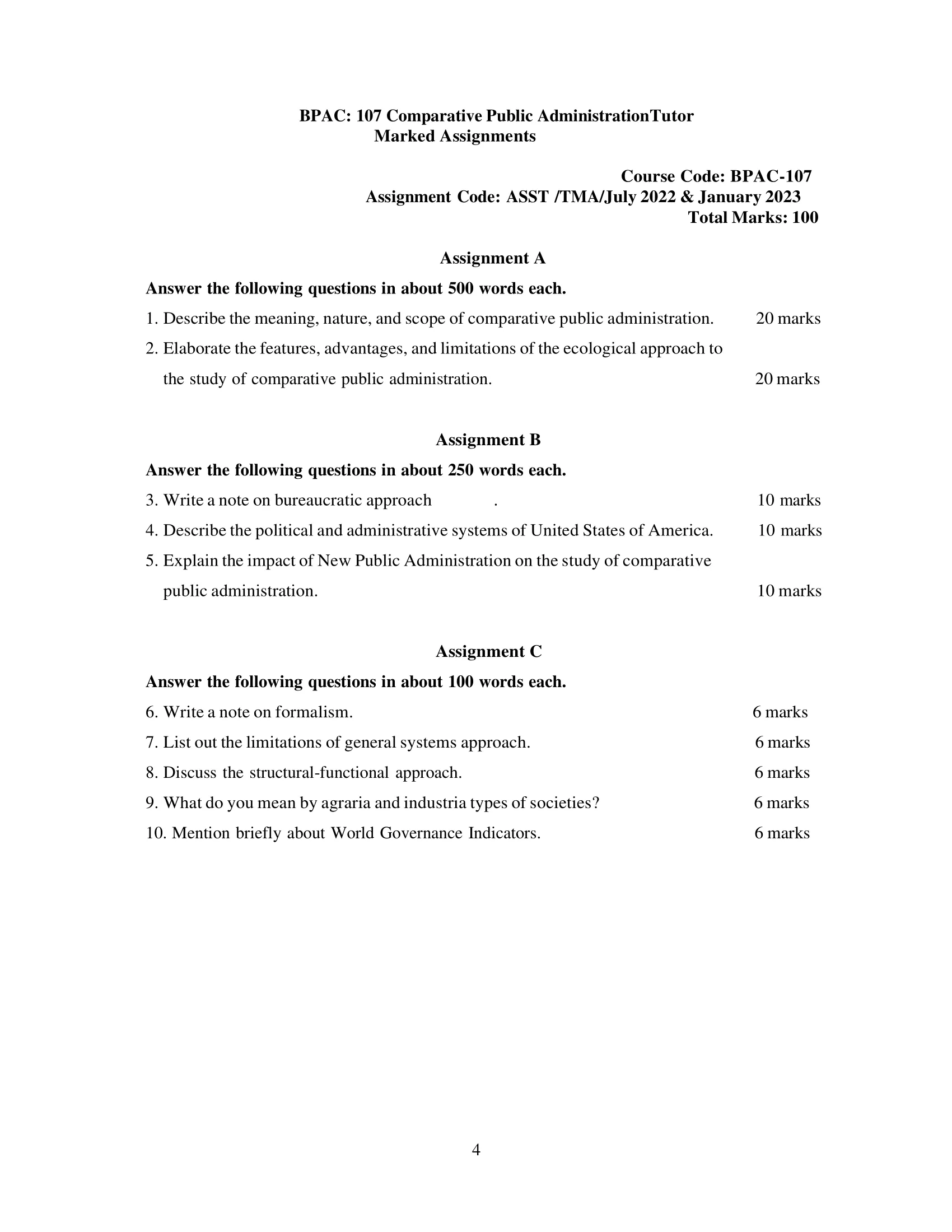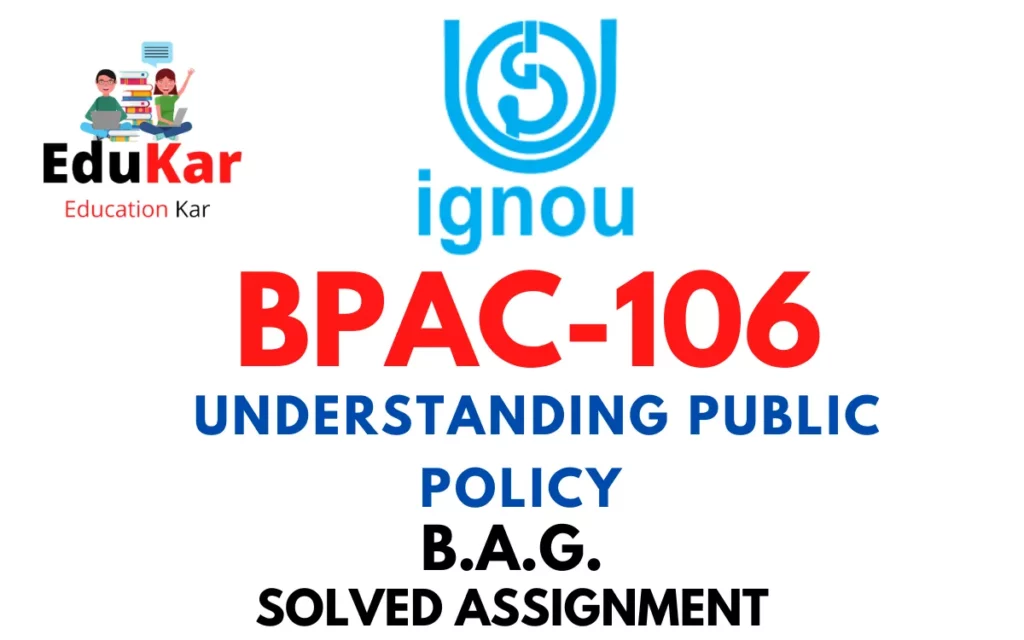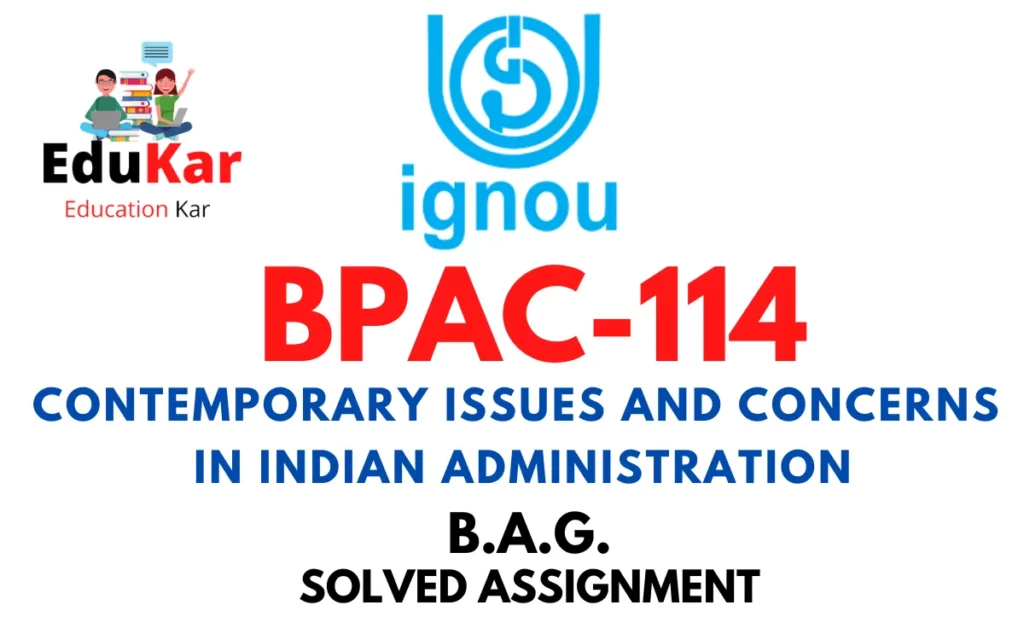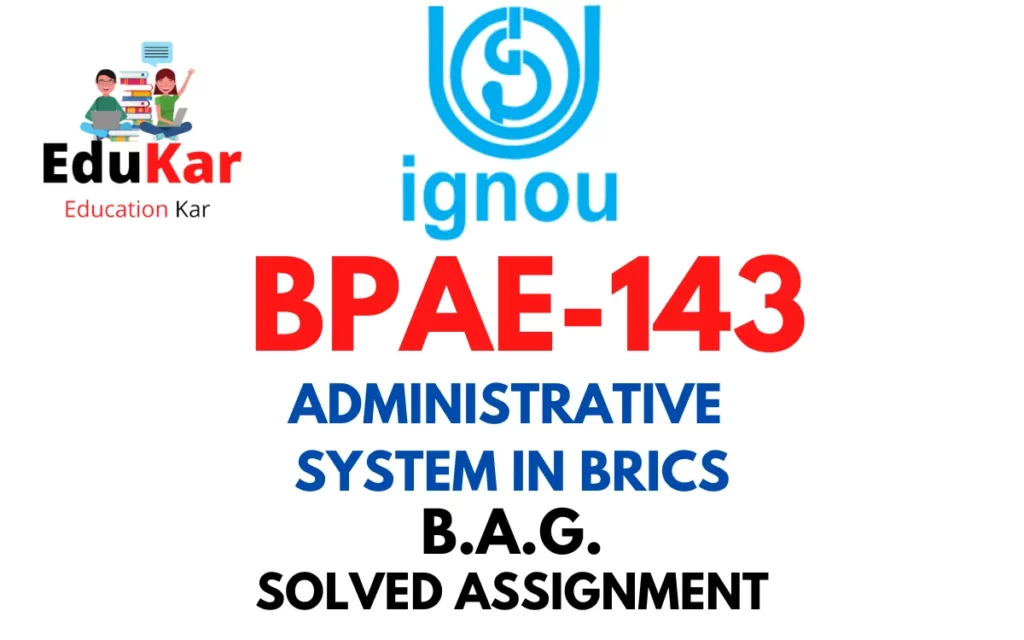Contents
- 1 Assignment A
- 2 Answer the following questions in about 500 words each.
- 3 1. Describe the meaning, nature, and scope of comparative public administration.
- 4 2. Elaborate the features, advantages, and limitations of the ecological approach to the study of comparative public administration.
- 5 Assignment B
- 6 Answer the following questions in about 250 words each.
- 7 3. Write a note on bureaucratic approach .
- 8 4. Describe the political and administrative systems of United States of America.
- 9 5. Explain the impact of New Public Administration on the study of comparative public administration.
- 10 Assignment C
- 11 Answer the following questions in about 100 words each.
- 12 6. Write a note on formalism.
- 13 7. List out the limitations of general systems approach.
- 14 8. Discuss the structural-functional approach.
- 15 9. What do you mean by agraria and industria types of societies?
- 16 10. Mention briefly about World Governance Indicators.

| Title | BPAC-107: IGNOU BAG Solved Assignment 2022-2023 |
| University | IGNOU |
| Degree | Bachelor Degree Programme |
| Course Code | BPAC-107 |
| Course Name | Comparative Public Administration Tutor |
| Programme Name | Bachelor of Arts (General) |
| Programme Code | BAG |
| Total Marks | 100 |
| Year | 2022-2023 |
| Language | English |
| Assignment Code | ASST /TMA/July 2022 & January 202 |
| Assignment PDF | Click Here |
| Last Date for Submission of Assignment: | For June Examination: 31st April For December Examination: 30th September |

Assignment A
Answer the following questions in about 500 words each.
1. Describe the meaning, nature, and scope of comparative public administration.
Ans: Comparative Public Administration (CPA) is a subfield of Public Administration that involves studying and comparing the administrative systems, practices, and policies of different countries or regions. It is concerned with identifying and analyzing similarities and differences in administrative structures, processes, and functions across different political, cultural, economic, and social contexts. The main objective of CPA is to enhance our understanding of how public administration works in different settings and to identify best practices that can be applied in different contexts.
The nature of CPA is multidisciplinary, as it draws on theories and methods from various fields such as political science, sociology, anthropology, economics, and management. It also involves a comparative approach, which means that it relies on comparing and contrasting administrative systems and practices in different countries or regions. By comparing administrative practices and policies across different settings, CPA seeks to identify similarities and differences, understand the reasons for these variations, and develop new theories and concepts that can explain these phenomena.
The scope of CPA is broad and includes a range of topics related to public administration, such as public policy-making, budgeting and financial management, human resource management, administrative reform, accountability and transparency, e-government, and public-private partnerships. CPA also covers different levels of government, including national, state, and local governments, as well as international organizations such as the United Nations and the European Union.
The significance of CPA lies in its ability to provide policymakers, practitioners, and scholars with insights and lessons from different administrative systems and practices, which can be used to inform decision-making and improve the effectiveness and efficiency of public administration. By examining how different countries or regions address common challenges and problems, CPA can help identify successful strategies and best practices that can be adopted in different contexts.
2. Elaborate the features, advantages, and limitations of the ecological approach to the study of comparative public administration.
Ans: The ecological approach to the study of Comparative Public Administration (CPA) emphasizes the interdependence of administrative systems and their surrounding environment. It views administrative systems as complex systems that interact with their political, economic, social, and cultural contexts. The approach considers the following features, advantages, and limitations:
Features:
- Contextual analysis: The ecological approach recognizes the importance of analyzing the context of administrative systems in understanding their functioning.
- Interdependence: The approach emphasizes that administrative systems are interdependent with their environment, and any change in one component of the system can affect the other components.
- Dynamic nature: The ecological approach considers administrative systems as dynamic entities that change over time in response to changes in their environment.
- Holistic perspective: The approach views administrative systems as complex systems, and thus, it requires a holistic perspective to understand their functioning.
Advantages:
- Comprehensive analysis: The ecological approach provides a comprehensive analysis of administrative systems by considering their multiple dimensions and the interrelationships between them.
- Contextual understanding: The approach emphasizes the importance of context, which provides a more nuanced understanding of the functioning of administrative systems.
- Identification of key factors: The approach identifies key factors that influence the functioning of administrative systems and their outcomes.
- Policy relevance: The ecological approach is policy-relevant, as it can inform policymakers about the interdependent relationships between administrative systems and their context, and the need to consider these relationships when designing policies.
Limitations:
- Complexity: The ecological approach can be complex, requiring a large amount of data and resources to analyze administrative systems holistically.
- Limited generalizability: The approach’s emphasis on the context of administrative systems can limit its generalizability across different administrative systems and contexts.
- Subjectivity: The approach can be subjective, as the interpretation of the relationship between administrative systems and their environment can differ depending on the researcher’s perspective.
- Difficulty in isolating variables: The approach’s focus on interdependence can make it difficult to isolate specific variables that may influence the functioning of administrative systems.
Assignment B
Answer the following questions in about 250 words each.
3. Write a note on bureaucratic approach .
Ans: The bureaucratic approach is a management theory developed by Max Weber, a German sociologist, and a pioneer of modern organizational theory. The bureaucratic approach is based on the idea that a well-organized and rational system of administration is essential for efficient and effective management of an organization. In this approach, the organization is seen as a machine, and the focus is on developing formalized rules, procedures, and hierarchies to ensure that everything runs smoothly.
According to Weber, a bureaucracy is a hierarchical structure in which tasks are assigned to specific positions and authority is delegated to individuals based on their position in the hierarchy. The bureaucratic approach emphasizes the importance of clear lines of authority, standardized rules and procedures, and impersonal relationships between individuals in the organization.
One of the key advantages of the bureaucratic approach is that it provides a clear structure for decision-making and accountability. Because rules and procedures are clearly defined, it is easier to ensure that everyone in the organization is following the same guidelines and working towards the same goals. This can lead to increased efficiency and productivity, especially in large organizations where coordination can be a challenge.
However, the bureaucratic approach has also been criticized for its inflexibility and its tendency to stifle creativity and innovation. The emphasis on rules and procedures can make it difficult to respond to changing circumstances, and the hierarchical structure can create a rigid power dynamic that discourages input from lower-level employees.
4. Describe the political and administrative systems of United States of America.
Ans: The United States of America has a federal system of government, which means that power is divided between the national government and the individual states. The U.S. government is based on a system of checks and balances, in which each branch of government has the power to limit the power of the other branches. The U.S. government is composed of three branches: the executive, legislative, and judicial branches.
The executive branch is headed by the President, who is elected by the people for a term of four years. The President is responsible for enforcing laws and is assisted by the Vice President and a Cabinet of advisors. The Cabinet includes heads of various federal departments, such as the Department of State, the Department of Defense, and the Department of the Treasury.
The legislative branch is composed of the House of Representatives and the Senate, collectively known as Congress. Members of the House of Representatives are elected every two years, and the number of representatives for each state is determined by population. The Senate is composed of two senators from each state, regardless of population. Congress is responsible for making laws, approving budgets, and overseeing the operations of the federal government.
The judicial branch is headed by the Supreme Court, which is the highest court in the land. The Supreme Court is responsible for interpreting the U.S. Constitution and determining the constitutionality of laws. The Supreme Court is composed of nine justices who are appointed by the President and confirmed by the Senate.
The administrative system of the United States is also divided between the national government and the individual states. The federal government is responsible for overseeing certain areas, such as foreign policy, national defense, and immigration, while states are responsible for issues such as education, public health, and law enforcement.
The administrative system is also composed of various federal agencies, such as the Environmental Protection Agency (EPA), the Federal Bureau of Investigation (FBI), and the Internal Revenue Service (IRS). These agencies are responsible for carrying out specific functions and enforcing specific laws.
5. Explain the impact of New Public Administration on the study of comparative public administration.
Ans: The New Public Administration (NPA) is a movement that emerged in the United States in the late 1960s and early 1970s. The NPA sought to reorient public administration away from a focus on technical efficiency and towards a more democratic and humanistic approach. The NPA has had a significant impact on the study of comparative public administration in a number of ways.
First, the NPA emphasized the importance of context and culture in shaping public administration. This has led to a greater focus on comparative analysis of public administration across different countries and regions, and a recognition that public administration is not a universal phenomenon but is shaped by specific political, social, and cultural factors.
Second, the NPA emphasized the importance of citizen participation and public engagement in the policymaking process. This has led to a greater interest in studying the ways in which different countries and regions involve citizens in the policymaking process, and the impact that citizen participation has on the outcomes of public policy.
Third, the NPA emphasized the importance of social equity and justice in public administration. This has led to a greater interest in studying the ways in which different countries and regions address issues such as poverty, inequality, and discrimination through public policy, and the impact that these policies have on different segments of the population.
Assignment C
Answer the following questions in about 100 words each.
6. Write a note on formalism.
Ans: Formalism is an approach in the study of Public Administration that emphasizes adherence to formal rules, procedures, and structures in administrative decision-making and operations. It assumes that rules and procedures are rational, objective, and impartial, and that they should be followed rigorously to ensure accountability, transparency, and consistency. Formalism places a premium on the rule of law and legal authority, and it seeks to minimize discretion and subjectivity in administrative decision-making. Critics of formalism argue that it can lead to bureaucratic rigidity, inflexibility, and insensitivity to context, as well as undermine creativity and innovation in public administration.
7. List out the limitations of general systems approach.
Ans: The General Systems Approach (GSA) is a theoretical framework used to study complex systems, including administrative systems in Comparative Public Administration. Some of the limitations of GSA are:
- Oversimplification: GSA can oversimplify complex systems by breaking them down into smaller components, which can lead to a loss of information and nuances in understanding how the system operates.
- Lack of context: GSA does not account for the specific social, cultural, and political contexts in which administrative systems operate. It assumes a universal applicability of the principles and concepts of systems theory.
- Limitations of the model: The model of GSA is often criticized for being too mechanistic and not accounting for the role of human agency, values, and beliefs in shaping administrative systems.
- Difficulty in application: The practical application of GSA can be challenging due to the complexities of administrative systems and the limitations of available data.
- Inability to predict outcomes: GSA does not provide a clear understanding of the outcomes of administrative systems. Its focus is on the internal structure and processes of the system rather than the impact of the system on society or the environment.
- Limited explanatory power: GSA’s ability to explain the functioning of administrative systems is limited by its lack of consideration of the broader political, economic, and social contexts in which these systems operate.
8. Discuss the structural-functional approach.
Ans: The structural-functional approach is a theoretical framework used to analyze the structure and functions of organizations, including administrative systems. This approach emphasizes the interdependence of various components of administrative systems and the need for these components to work together in a coordinated way to achieve the organization’s goals.
The key features of the structural-functional approach are:
- Emphasis on the structure of the organization: The approach focuses on the organizational structure, which refers to the hierarchical arrangement of various units, departments, and positions within the organization.
- Emphasis on the functions of the organization: The approach emphasizes the functions that the organization performs to achieve its goals. Functions are the tasks, roles, and activities that are necessary for the organization to carry out its mission.
- Emphasis on the interdependence of components: The approach emphasizes the interdependence of various components of the organization, such as different departments and positions. Each component has a specific role to play, and the efficient functioning of the organization depends on the effective coordination of these components.
- Systematic analysis: The structural-functional approach provides a systematic framework for analyzing administrative systems. It helps identify the key components of the system and the functions that these components perform.
Advantages of the Structural-Functional Approach:
- Comprehensive analysis: The structural-functional approach provides a comprehensive analysis of administrative systems, including their structure, functions, and interdependencies.
- Identification of problems: The approach helps identify problems and inefficiencies in administrative systems by analyzing the functions of different components of the system.
- Emphasis on coordination: The approach emphasizes the need for coordination and integration between different components of administrative systems, which can improve organizational efficiency and effectiveness.
- Policy relevance: The structural-functional approach is policy-relevant, as it can inform policymakers about the need to structure administrative systems in a way that promotes efficient functioning.
Limitations of the Structural-Functional Approach:
- Lack of consideration for the external environment: The approach does not take into account the influence of external factors such as the political, social, and economic environment in which the organization operates.
- Oversimplification: The structural-functional approach can oversimplify complex administrative systems by breaking them down into discrete components and ignoring the complexity and diversity of the organization.
- Limited attention to conflict: The approach does not give adequate attention to conflict and power dynamics within the organization, which can affect the functioning of the system.
9. What do you mean by agraria and industria types of societies?
Ans: Agrarian and industrial societies are two types of societies that are defined by their economic systems, social organization, and technological advancement.
Agrarian societies are characterized by a dominant agricultural economy, where the majority of the population is engaged in farming and food production. Agrarian societies tend to be rural, with most people living in small villages or communities. Social organization in agrarian societies is often hierarchical, with power and wealth concentrated in the hands of a small elite, such as feudal lords or landowners. Technological advancement in agrarian societies is typically limited, with most agricultural work being done by hand or with basic tools.
Industrial societies, on the other hand, are characterized by a dominant industrial economy, where manufacturing and production of goods is the primary economic activity. Industrial societies tend to be urban, with large cities and urban centers. Social organization in industrial societies is often more democratic and egalitarian, with a greater emphasis on individual rights and freedoms. Technological advancement in industrial societies is often more advanced, with the use of complex machinery and technology to improve efficiency and productivity.
The transition from agrarian to industrial societies, often referred to as the Industrial Revolution, took place in the late 18th and early 19th centuries in Europe and North America. The development of new technologies such as the steam engine, the spinning jenny, and the power loom allowed for the mass production of goods and the growth of industry. This led to a shift from an agrarian to an industrial economy, which brought about significant changes in social organization and technological advancement.
Today, most societies around the world are industrial societies, with a few exceptions in more rural or underdeveloped regions. However, the transition from agrarian to industrial societies has not been uniform across the globe, and some societies are still in the process of making this transition.
10. Mention briefly about World Governance Indicators.
Ans: The World Governance Indicators (WGI) is a project of the World Bank that measures the quality of governance in countries around the world. The WGI assesses six dimensions of governance: voice and accountability, political stability and absence of violence, government effectiveness, regulatory quality, rule of law, and control of corruption. The indicators are based on a combination of data from surveys of citizens, businesses, and experts, and objective measures such as budget and audit reports. The WGI is widely used by researchers, policymakers, and investors to measure the quality of governance and to identify areas for improvement in different countries.
How to Download BPAC-107 Solved Assignment?
You can download it from the www.edukar.in, they have a big database for all the IGNOU solved assignments.
Is the BPAC-107 Solved Assignment Free?
Yes this is absolutely free to download the solved assignment from www.edukar.in
What is the last submission date for BPAC-107 Solved Assignment?
For June Examination: 31st April, For December Examination: 30th October















